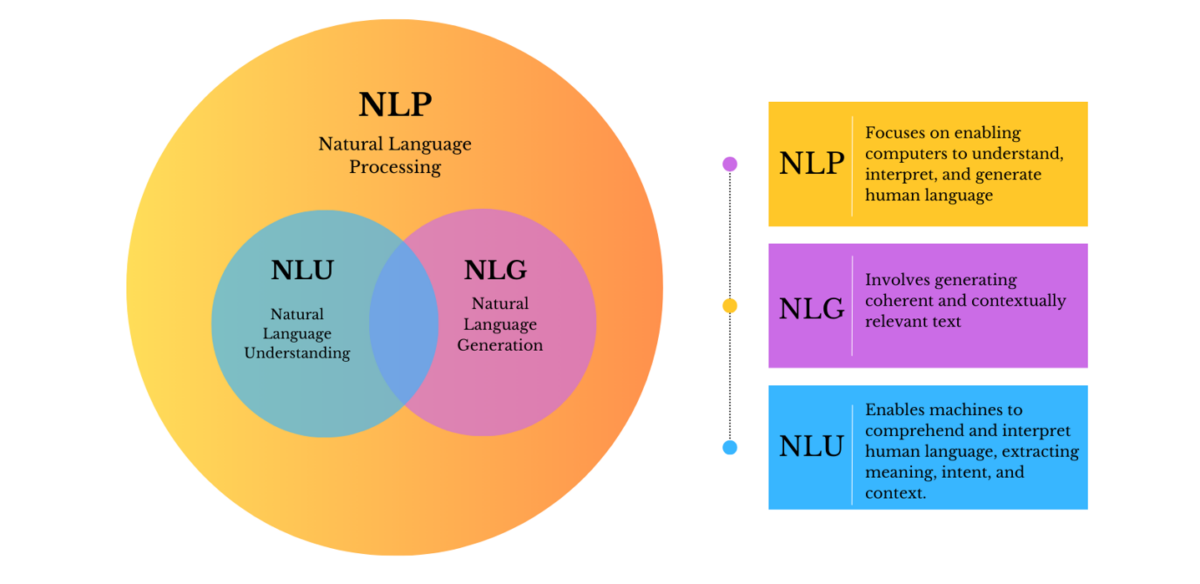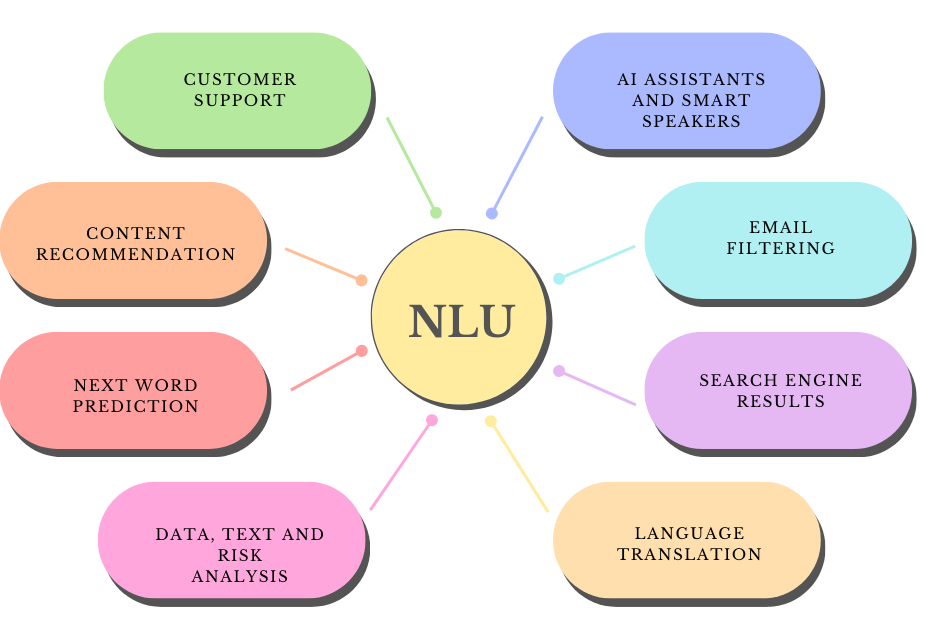Have you ever wondered how computers understand what we say or write? That’s where Natural Language Understanding (NLU) comes in. It helps computers understand the real meaning behind our words.
In this article, I’ll explain how NLU works and why it’s essential for making our conversations with computers smoother and more meaningful. Let’s dive into the world of NLU!
What Is Natural Language Understanding?
Natural Language Understanding (NLU) pertains to a field within artificial intelligence dedicated to processing user-provided input data in natural language, such as text or speech.
It facilitates computer-human interaction by allowing computers to understand and respond like human communication, understanding natural languages like English, French, Hindi, and others.
NLP vs. NLU vs. NLG
Natural Language Understanding (NLU) and Natural Language Generation (NLG) are part of Natural Language Processing (NLP). Let’s find out how they’re different.

| Natural Language Processing (NLP) | Natural Language Understanding (NLU) | Natural Language Generation (NLG) |
|---|---|---|
| Subset of AI for communication between humans and machines using natural language. | Focuses on processing user-provided input in natural language for interaction with computers. | Sub-component of NLP that generates output in natural language based on user input. |
| Analyzing and processing linguistic elements to understand the structure of language. | Helps in extracting and understanding meaning, intent, and context from human language, going beyond structural analysis. | Helps in generating human-like language or text based on given data or information. |
| Help to Communicate in natural language rather than coded or byte language. | Understanding user input in natural language, including text or speech data. | Generating output in the same language as the user’s input. |
| Enhancing human-machine communication, making instructions more intuitive. | Enabling computers to understand and respond to users in various natural languages. | Generating coherent and contextually relevant responses in natural language. |
Importance of NLU in AI Development

- NLU makes communication with computers easy, allowing machines to understand and respond to natural language from humans.
- NLU is crucial for finding important information in huge amounts of unorganized text data, helping with decisions based on data.
- NLU creates personalized user experiences by understanding user intent, preferences, and sentiments. It provides recommendations accordingly.
- NLU streamlines processes by automating the understanding of natural language queries, enhancing efficiency, and contributing to the development of intelligent systems.
- NLU fuels innovation in various sectors, from healthcare to customer service, by advancing conversational interfaces, sentiment analysis, and data-driven insights.
- NLU makes technology more accessible by letting people interact in natural language. It lowers barriers to using technology and promotes inclusivity in the digital world.
How NLU Works

Natural Language Understanding (NLU) encompasses several steps. Let’s simplify and break down these steps for better understanding.
#1. Understanding Commands
The first step of understanding NLU focuses on the meaning of dialogue and discourse within a contextual framework. The primary goal is to facilitate meaningful conversations between a voicebot and a human.
Ex- Giving commands to chatbots, such as “show me the best recipes” or “play party music,” falls within the scope of this step. It involves understanding and responding to user requests within the context of the ongoing conversation.
This process involves two main processes: Tokenization and Part of Speech Tagging
Tokenization
Breaking down the input text into smaller units, such as words or phrases.
Ex- For the sentence “Sanket is a student,” tokenization would result in the tokens: [“Sanket”, “is”, “a”, “student”].
Part-of-Speech Tagging (POS)
Assigning grammatical categories (e.g., nouns, verbs, adjectives) to each token.
Ex- Tagging the tokens from the previous step: [“Sanket” (noun), “is” (verb), “a” (article), “student” (noun)].

NLU is a part of NLP, so I have explained the steps that will help computers understand the intent and meaning of a sentence. Therefore, do not misunderstand it as a different concept.
However, can machines understand directly what the user meant even after comprehending tokenization and part of speech? No! To achieve that, we need to understand our next step.
#2. Compositional Semantics
The second step of NLU is centered around “compositional semantics,” where the meaning of a sentence is constructed based on its syntax and structure.
Compositional semantics involves grouping sentences and understanding their collective meaning. Using previous linguistic knowledge, NLU attempts to decipher the meaning of combined sentences.
For instance, understanding that the command “show me the best recipes” is related to food represents the level of comprehension achieved in this step.
Let’s break it down more deeply:
Syntactic Parsing
Analyzing the grammatical structure to understand the relationships between words in a sentence.
Ex- Identifying the syntactic structure of the sentence to reveal the subject (“Sanket”) and predicate (“is a student”).
Named Entity Recognition (NER)
Identifying and classifying entities (e.g., names of people, organizations, locations) in the text.
Ex- Recognizing “Sanket” as an entity, classifying it as a person.
Semantic Role Labeling (SRL)
Identifying the roles of words or phrases in a sentence with respect to a specific verb.
Ex– In the sentence “She gave him a book,” SRL identifies “She” as the giver, “him” as the recipient, and “a book” as the object.

Now, let’s move towards our final step:
#3. Lexical Semantics
The highest level of Natural Language Understanding focuses on understanding the meaning of individual words and phrases. It involves studying the meaning of each word and deriving the meaning of individual words from sentences.
Ex- For a given sentence like “show me the best recipes,” the voicebot breaks it down into its constituent parts: “show,” “me,” “the,” “best,” and “recipes.” The system then individually focuses on the meaning of each word, deriving their semantic significance.
The next step involves combining these individual word meanings to process user queries and provide results based on the overall meaning of the words. In this step, the focus is on semantic meaning and identifying different words with the same meaning.
Sentiment Analysis
Determining the emotional tone or sentiment expressed in the text.
Ex- Analyzing the sentiment of the sentence “I love this product” as positive.
Coreference Resolution
Identifying when different words or expressions refer to the same entity.
Ex- Resolving that “He” in one sentence refers to the same person as “Sanket” in another sentence.
After going through all these steps, the model will be able to determine the user’s intent based on the words, sentence structure, and vocabulary used in the sentence.
Applications of NLU

AI Assistants and Smart Speakers (IoT)
NLU helps in understanding and interpreting user voice commands by extracting meaning and intent from spoken language. NLU is fundamental to voice-activated devices like Amazon Alexa and Google Home, enabling them to understand and respond to human language naturally.
It segments words and sentences, recognizes grammar, and uses semantic knowledge to infer user intent, creating more natural and interactive conversational interfaces.
Language Translation

NLU, as a part of machine learning algorithms, plays a role in improving machine translation capabilities. It enables algorithms to analyze context and linguistic nuances in millions of pages of text, contributing to more accurate translations compared to word-for-word substitutions.
The more training data the algorithm receives, the better it becomes at generating natural language text and providing accurate translations.
Search Engine Results
NLU improves the understanding of user queries, enabling search engines to provide more accurate and contextually relevant search results. It allows search engines to better interpret the user’s intent behind the search query.
Customer Support and Service
NLU powers chatbots, enabling them to engage in natural language conversations with users through text or voice. It involves processes such as feature extraction, classification, entity linking, and knowledge management to provide effective answers to user queries.
NLU assists in understanding the sentiment behind customer feedback, providing businesses with valuable insights to improve products and services. Intelligent personal assistants, driven by NLU, contribute to customer service by handling frequently asked questions and assisting users in a more human-like manner.
Content Recommendation
NLU helps in understanding user preferences by analyzing natural language expressions and improving the accuracy of content recommendations. NLU is employed for customer sentiment analysis, helping organizations parse through social media comments to determine the overall sentiment (positive or negative) toward the company or its products.
It also aids in understanding user intent by analyzing terms and phrases entered into a website’s search bar, providing insights into what customers are looking for.
Interactive Voice Response (IVR) and Message Routing

NLU enhances IVR systems by allowing users to interact with the phone system via voice, converting spoken words into text, and parsing the grammatical structure to determine the caller’s intent.
The inclusion of NLU in IVR systems makes self-service and call routing more intuitive and responsive to natural language queries.
Email Filtering and Risk Analysis
NLU assists in analyzing the content and context of emails to identify and filter out spam. It helps categorize emails based on their content, ensuring that they are organized and easily accessible to users.
NLU is used to analyze the natural language content in workplace communications, identifying potential risks, compliance issues, or inappropriate language.
Final Words
In recent years, the fields of Natural Language Processing (NLP) and NLU have seen significant improvement, and we are incorporating them into our daily lives. Natural Language Understanding (NLU) is an important part of AI, with numerous real-life applications such as AI assistants, email filtering, content recommendation, customer support, and many more.

